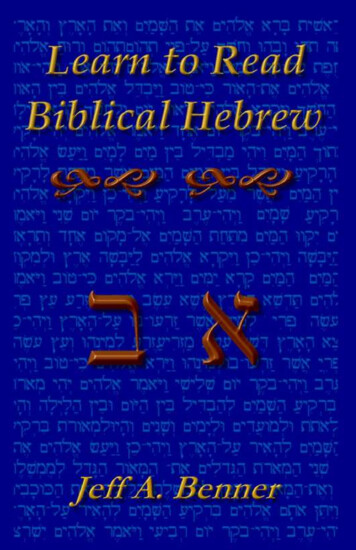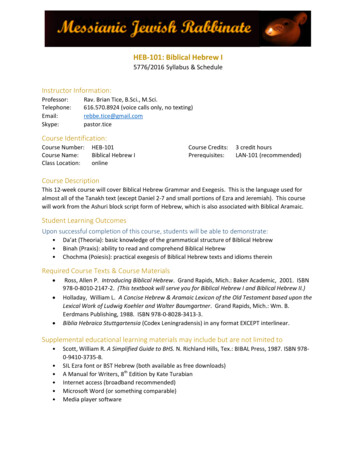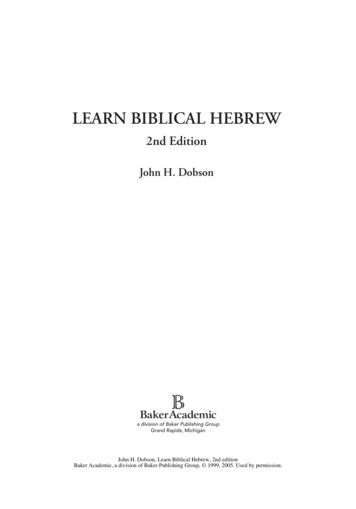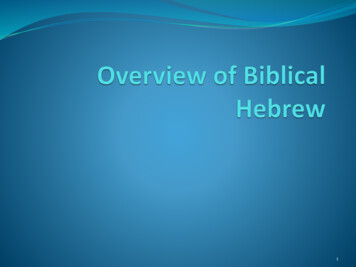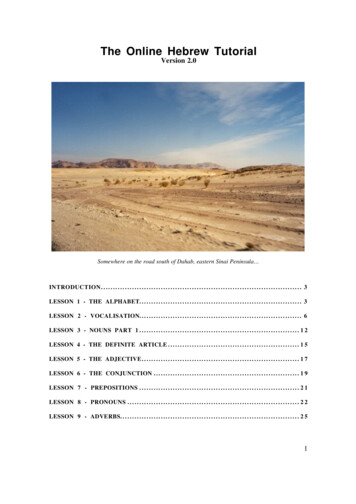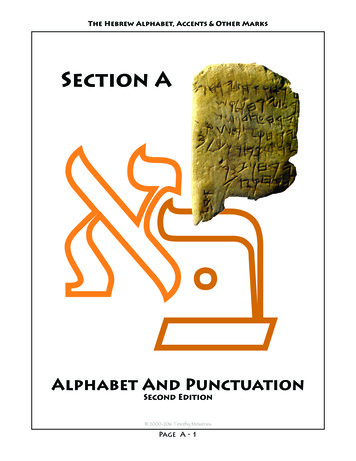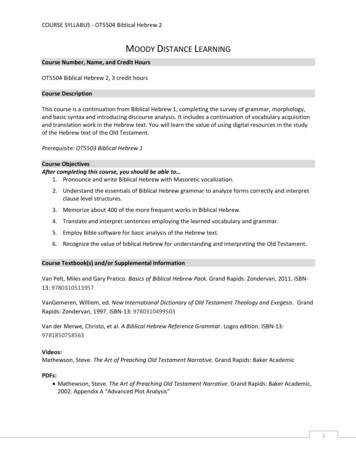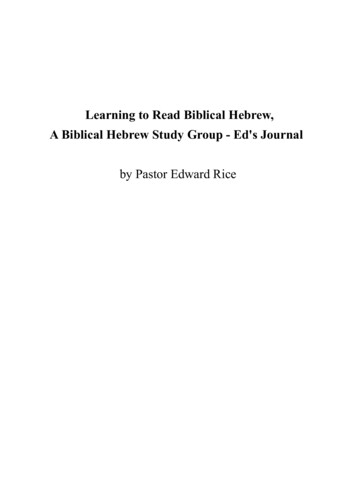
Transcription
Learning to Read Biblical Hebrew,A Biblical Hebrew Study Group - Ed's Journalby Pastor Edward Rice
Copyright 2013 by Pastor Edward Rice English Scripturequotations are taken from the Authorized King James Bible.Commercial Rights Reserved. For non-commercial purposes any portion ofthis book may be reproduced, stored in a retrieval system, or transmitted inany form or by any means electronic, mechanical, photocopy, recording, orotherwise in the service of our Creator, Lord and Saviour, Jesus Christ theRighteous. This constitutes the written permission of the author.Compiled and Edited by Pastor Edward RiceEdited by Beverly E. RiceCover design by AuthorLayout by AuthorPublished by E.G.RicePublishingvia GSBaptistChurch.comPO Box 99, Dresden, NY 14441ISBN (Pending)Printed in the United States of America
A Biblical Hebrew Study Group - Ed's Journal3
DedicationMy journey into Biblical Hebrew is journaled herewith the expectation that my children and mychildren's children will soon walk this path. Onlyloving the Lord their God with all their heart, with alltheir soul, and with all their mind would take themdown such a path. I have no greater joy than to knowthat my children walk in truth.
v
Table of efaceixChapter 1 Introduction. 1Quiz Chapter 1 .6Chapter 2 Biblical Hebrew's Alphbet.7Quiz Chapter 2 .12Chapter 3 Biblical Hebrew's Vowels and Syllables.13Chapter 3 Vocabulary.19Quiz Chapter 3 .21Chapter 4 Biblical Hebrew's Plural Nouns. 22Chapter 4 Vocabulary.29Quiz Chapter 4 .31Chapter 5 Biblical Hebrew's Definite Article. 32Chapter 5 Vocabulary .37Quiz Chapter 5 .39Chapter 6 Biblical Hebrew's Prepositions.40Chapter 6 Vocabulary.48Chapter 7 Biblical Hebrew's Adjectives. 50Chapter 7 Vocabulary.52Chapter 8 Biblical Hebrew's Pronouns. 55Chapter 8 Vocabulary.59Chapter 9 Hebrew Pronominal Suffixes . 61Chapter 9 Vocabulary.63Chapter 10 Hebrew Construct Chain. 65Chapter 10 Vocabulary.67Chapter 11 Hebrew Numbers.69Chapter 11 Vocabulary.76vi
Chapter 12 Introduction to Hebrew Verbs. 78Chapter 12 Vocabulary.85Chapter 13 Qal Perfect Strong Verbs. 86Chapter 13 Vocabulary Verbs.91Chapter 14 Qal Perfect – Weak Verbs.92Chapter 14 Vocabulary.101Chapter 15 Qal Imperfect - Strong Verbs.103Chapter 15 Vocabulary.106Chapter 16 Qal Imperfect - Weak Verbs. 108Chapter 16 Vocabulary.111Chapter 17 Waw Conversive.112Chapter 17 Vocabulary.116Chapter 18 Qal Imperative, Cohortative and Jussive .117Chapter 18 Vocabulary.121Chapter 19 Pronominal Suffixes on Hebrew Verbs.123Chapter 19 Vocabulary.126Chapter 20 Qal Infinitive Construct.127Chapter 20 Vocabulary.127Chapter 21 Qal Infinitive Absolute. 129Chapter 21 Vocabulary.129Chapter 22 Qal Participle.131Chapter 22 Vocabulary.131Chapter 23 Issues of Sentence Syntax. 133Chapter 24 The Niphal Stem – Strong Verbs.135Chapter 25 The Niphal Stem – Weak Verbs.136Appendix BST Hebrew-English Font Keyboard Map.151Appendix Study Schedule.153Appendix Psalm Reading Schedule. 155vii
AcknowledgmentsIn my teen years at Tuscorora Baptist Church outsideAddison NY, it was pointed out to me that Psalm 119 was anacrostic with groupings of 8 verses all starting with the 22letters of the Hebrew Alphbet and that the Hebrew Alphbet hasno vowels only consonants, or if you would 'n vwls nlycnsnnts.' Skeptic of both declarations I determined then that Iwould someday learn Biblical Hebrew. Seminary training andlearning priorities required a year of Greek first. Therein Iunderstood the challenge of learning Biblical languages but Ialso tasted the joy. Professor Rodney Decker, of Bible BaptistSeminary in Clark Summit Pennsylvania wrote in myTrinitarian Bible Society Greek New Testament (I refused touse their Nestles Version) “Remember Luther's comment thatthe biblical languages, Greek and Hebrew, are the sheath inwhich the sword of the Spirit rests.” After my Masters ofTheological studies and before my Doctorate of Philosophy inthe same commenced, at age 60 and well after lost skepticism, Idetermined via self study to pursue that teenage goal.viii
Forwardix
Prefacex
A Biblical Hebrew Study Group - Ed's Journal1Learning to Read Biblical HebrewEd's Journalby Pastor Edward RiceChapter 1 IntroductionRomans 3:1-2 What advantage then hath the Jew? or whatprofit is there of circumcision? Much every way: chiefly,because that unto them were committed the oracles of God.Learning the Hebrew language enough to read a HebrewBible will be a challenge. A challenge for challenge sake isgreat for 6 year olds, but for the more mature, there needs to bea greater purpose in taking on such a challenge. Since yourreading this in English, you once learned the alphabet, the soundeach letter adds, and the word it pronounced.Hebrew is intriguing in that it is made up of letters whichare very foreign to English, and that these 22 foreign letters areall consonants. Additional consternation is encountered by somewhen they consider that in Hebrew letters are often given duosyllable names “Aleph – Bet – Gimel” and “Ayin- Pe – Tsade,”while in English our letters are straight forward one syllablenames “A-B-C” and “Q-R-S”. The first challenge then is tolearn these letters, learn their names, and learn their sounds.This is not a new challenge. We faced it previous. It was infirst grade when the letters were “A-B-C”. Memorize theseletters just like you did back then, it will take your mind to anew but familiar vista.
2Learning to Read Biblical HebrewThe letters are best learned via this flash card:Take yourself back to first grade, read them write them,memorize them and learn them. Why are there 23? When thereare supposed to be 22? Oh the intrigue of learning.
A Biblical Hebrew Study Group - Ed's JournalAnother flash card that is just as functional is given here.Here it is useful to consider that Hebrew reads from right toleft, not in our normal English flow. Notice that here?3
4Learning to Read Biblical HebrewYou are, again, challenged to do some rote memorizationwithout understanding all the details. Do not repeat the childishquestion “Why do I have to learn this?” That is childish! Themore mature question is Why am I learning to read Hebrew?When a teenager I was told that Psalm 119 was a Hebrewacrostic with groups of 8 verses all starting with the 22 letters ofthe Hebrew alphbet.1 My Oxford press Scofield Bible evenwent to the great care of printing the Hebrew letters before eachoctet. I was intrigued enough then to know that someday Iwould learn all those queer shapes with strange names andcheck this hypothesis out with an actual Hebrew Bible. I firstlearned the Hebrew alphbet by reading my King James Bible,and twice a year in Psalm 119, I paused to write out the HebrewAlphbet.Since inception the study of Biblical languages wasconstitute as a fundamental and significant part of the trainingof the human intellect. The prideful arrogance of the postmodernist student who thinks English is the perfected end-all ofevery language might need be addressed here, but only briefly.One Dr. Peter Ruckman and his followers have championed amisguided cause that the English is far superior to the originallanguages, making anyone who knows, uses or learns theoriginals an inferior turncoat and hypocrite who threatens theirKJV only stance. It is unfortunate that so many independentswith a mysterious draw to isolationism echo his refrain It needsto be clearly stated that study of the Greek and Hebrew cannotimprove or enhance what we have recorded in the King JamesEnglish, but we must not shy away from their insults and threatsto make such study insignificant.1 I was not told at that time that 'alphbet' was the accepted spelling of'alphabet' but the logic, you see, becomes apparent in time and study.
A Biblical Hebrew Study Group - Ed's Journal5In 1999 my Greek professor Rodney Decker wrote inside myGreek TR, “The Biblical Languages, Greek and Hebrew are thesheath in which the sword of the Spirit rests.” Mere modernisthumans will never improve on the King James English Bibletranslation or Bible language. It should never come from apreachers mouth “A better translation is .” The team oftranslators assembled by King James will never be equaled, andwhen some scholar who got a B in 2 years of Greek tries tochange English words of the King James Bible just back awayfrom them slowly. So I must clarify that we do not learnHebrew so that we can improve the King James English,however our learning of Greek and Hebrew can most certainlyimprove our King James English even as it increases our faith inthe King James translators.Three reasons I have considered for learning to read myHebrew Bible are 1) I love the Lord my God and he first spoketo humanity in Hebrew. 2) I love the revelation of the Lord myGod and 39 books of His written revelation were recorded inHebrew, and 3) I love to learn new things believing that whenyou stop learning your brain starts aging and God commands usto Study to shew yourself approved unto a God a workman thatneedeth not be ashamed, rightly dividing the word of truth.Given those three, just for starter reasons, one should walk intothis learning experience with an anticipation that more concretereasons will soon develop.On that note, learn your Hebrew alphbet. Use the resourceslisted below to be a help for that learning process.Helpful resources atwww.GSBaptistChurch.com/hebrew study group/alpha slow.mp3 ,alpha fast.mp3 , 3x5hbrw00.jpg , 3x5hbrw01.jpg , hbrw gen1 1.wmv ,hbrw jonah2 1.wmv , psalm1n2.jpg , alphbet.pngWith this most helpful link http://eteacherbiblical.com/free-lessons
6Learning to Read Biblical HebrewQuiz Chapter 1Nobody likes quizzes but everybody needs them, even self-study students.On a separate paper complete these 12 closed book exercise in one sitting,then grade your own work each one counting 10 points, then report yourgrade to someone, even if it is your spouse.“Write” each Hebrew Letter Named Below.1) Aleph Bet2) He Chet3) Tet Lamed4) Mem Mem Final Form5) Tzad Tzad Final Formlea'r.fiy7) Translate to English hy'h.y8) Translate to English ;lvWr.y9) Translate to English hevmo10) Write the English name of the Hebrew letter Q11) Write the English name of the Hebrew letter p12) Write the English name of the Hebrew letter r6) Translate to EnglishAnswer Key: 1-5) Consult Alphbet Chart; 6) Gen 32:32 5th word,. 7) Isa 12:216th word, 8) Josh 10:1 10th word, 9) Exod 2:11 10th word, 10-12) ConsultAlphbet Chart.This quiz has a built in curve to make you feel better about yourself.If you score over 100 points just round down to the nearest 100th.
A Biblical Hebrew Study Group - Ed's Journal7Chapter 2 Biblical Hebrew's AlphbetWhom shall he teach knowledge? and whom shall he make tounderstand doctrine? them that are weaned from the milk, anddrawn from the breasts. For precept must be upon precept,precept upon precept; line upon line, line upon line; here alittle, and there a little: For with stammering lips and anothertongue will he speak to this people. Isa 28:9-11The most powerful learning tool in the world is repetition. In adementia course given by Dr. Ziesel on PBS he outlined verywell four learning or memory methods as follows:1) Declarative Learning – whereby we learn/rememberfacts, like the capital of Texas, and the year of the war of18122) Episodic Learning – Whereby we learn/rememberexperienced events, like what we had for breakfast lastThursday.3) Emotional Memory – Whereby we never forget wherewe had our first kiss or where we were on 9/11, olderones where we were when JFK was shot, pearl harborbombed etc.4) Procedural Learning – Whereby we learn by doingpracticing and doing, learning to ride a bike, play thepiano, read, etc.We should notice here that riding a bike, playing a piano andreading are accomplished via procedural learning, morecommonly called 'practice, practice, practice,'. she lives withher sister 'practice makes perfect.' If you are going to learnBiblical Hebrew, or Algebra, you will need to do it a little bitevery day, not once a month on a Friday afternoon.
8Learning to Read Biblical HebrewThe best way to accomplish procedural learning is with aprocedure which is often called a schedule. The appendix of thisjournal includes my Hebrew Bible Reading Schedule wherebyall 2,461 verses of the book of Psalm are read at approximately7 verses per day. That takes one calendar year. Start on today'sdate even if it is in the middle of the book; it is just not thatcritical where you start but it is critical that you start. This canbe done for free with the free e-Sword Bible with the HOT2 andHOT free download all available at www.e-sword.net but Ihighly recommend that it be done with that plus a BiblicHebraica Stuttgartensia3, second edition, amended 1977. It iswritten right to left with Hebrew chapter numbers and includesexcellent vowel points that are missing from e-Sword. I boughtmine for 24.95 on 6/11/2005 from a Menonite Book Store inLancaster PA. Christian book stores are not really that Christiansince the modernists moved in4.2 It took a while for me as well but HOT stands for Hebrew Old Test.34This Hebraica Stuttgartensia is recommended for content of Hebrew with vowel points, notfor content of Scripture. According to Jerry Rockwell of firstBible International, via"Unpublished Word", Vol 10, Num 1, Spring 2013, and Bleddyn J. Roberts' “The OldTestament: Manuscripts, Text and Versions” (pgs 10-11) and the “Cambridge History of theBible”, NY, Cambridge University Press, 1969, the Biblia Hebraica is from the ben AsherHebrew text, a critical text, and not from the ben Chayyim text that is the basis of theAuthorized Version (KJV). In 1524-1525 Jacob ben Chayyim, a Hebrew Christian, puttogether the Second Rabbinic Bible. The First Rabbinic Bible had disappeared from historyand ben Chayyim, like Erasmus for the Greek Text, went seeking evidence of the HebrewText, compiling a four volume edition. This Second Rabbinic Bible became the TextusReceptus of the Hebrew, is often called the Masoretic text, and was used by the King Jamestranslators. (It was NOT used by the New King James translators else they would not gettheir copy rights) (You know by now that the prefix 'ben' is Hebrew for 'son of', it is good tostudy Hebrew) This Hebraica Stuttgartensia, is recommended because of its easy access toHebrew students and NOT for its certain origins. Be ye careful. The HebraicaStuttgartensia is indeed a version of the corrupt Biblia Hebraica family of error and may beused effectively to study the Hebrew language but not the Hebrew Scripture. Thank youPastor Bruce Varner.Christianbook.com gives this promotional Product Description: Biblia HebraicaStuttgartensia (BHS) is known to be the definitive edition of the Hebrew Bible. It is arevision of the third edition of the Biblia Hebraica edited by Rudolf Kittel, the first Bible tobe based on the Leningrad Codex. The Leningrad Codex is the oldest complete HebrewBible still preserved. It originally appeared in installments, from 1968 to 1976, with the first
A Biblical Hebrew Study Group - Ed's Journal9It is true that 7 verses per day is a big challenge when one hasto look up every letter on a 3x5 card to find its name andpronunciation, but it is worth ever upfront effort and you will getover the clumsiness of it in about two weeks. It will thennaturally ease you into wondering about the vowels for thesewords and that gets answered well in Lesson 3. It will next easeyou into various parts of speech and their forms which willintroduce concepts yet to come. This is an essential andpowerful tool for learning and must be included for an easysuccess story. “I learned Biblical Hebrew through self study andhere is how I did it ” Until you get your Hebrew Bible withvowel points there are some Psalm text's available on line.GSBaptistChurch.com/hebrew study group/psalm1n2.jpg ,GSBaptistChurch.com/hebrew study group/psalm3n4n5 7.jpgone-volume edition in 1977; it has since been reprinted many times. The text is a nearlyexact copy of the Masoretic Text as recorded in the Leningrad Codex. The Masoretic notesare completely revised. Included is a foreword in German, English, French, Spanish andLatin as well as an English and German key to the Latin words, abbreviations and othersymbols in the critical apparatus. This Biblia Hebraica Stuttgartensia (BHS) StandardEdition features a larger size, footnotes, bigger margins, a ribbon marker, and a generallymore spacious appearance, making it particularly accessible to the student engaged inintense language study. Notice in this description that this is a corrupt critical text.
10Learning to Read Biblical HebrewIt is likely already obviated that the Hebrew reads from rightto left. This unnerving characteristic became most intriguingafter I bought my Hebrew Bible. The title page is placed inwhat we call the very back of the book, as we would say'preceded by' a table of context giving the Bible book names,chapter counts and page numbers, of which I guessed only thelater two because they were Arabic numbers, and even these
A Biblical Hebrew Study Group - Ed's Journal11were given 'backward' with page numbers on the extreme leftmargin. Again what we call 'preceding' all this was what Iperceived to be the first page of the book of Genesis. It wasnecessary that I pursue this intrigue. And now, seven years later,here I am still in that pursuit but determined to make this 8th yearnew and grandiose. I still read left to right and pick up myHebrew Bible either upside down or open to the Revelation ofJesus Christ chapter 22. The intrigue is undiminished. You mustread Biblical Hebrew from right to left and rehearse thischaracteristic in each moment of study.Learning the pronunciation of the 22 consonants of theHebrew alphbet is paramount and accomplished by practice,practice, practice. Discerning the letters that look alike, bet andkof, dalet and resh, vaw, zain, and final nun; or the final formsof kaf, mem, nun, pe, and tzade; quickly recognizing thedifference between sin and shin; all these are challenges that willonly be proceduralized by practice, practice, practice. Reading alittle Hebrew daily can be exciting, but a great help is found inwatching others in this struggle. While it is available for freeonline one should take full advantage of eTeacher material, i.e.the 10 free lessons found at http://eteacherbiblical.com/freelessons . Several verses being read by several students havebeen captured from their Thursday night Hebrew Webinarfound at: .do?siteurl eteacher. Many are put in wmv format and available onCD from the author or available at:http://www.gsbaptistchurch.com/hebrew study group/scripture/where you will find:hbrw gen1 1.wmvhbrw gen11 3.wavhbrw gen28 1.wmvhbrw gen28 16.wmvhbrw gen28 3.wmvhbrw zech8 11to12.wmvhbrw gen1 1to3.wmvhbrw gen11 3.wmvhbrw gen28 10.wmvhbrw gen28 18.wmvhbrw gen28 5.wmvhbrw zech8 16to17.wmvhbrw gen9 24.wmvhbrw jonah2 1.wmvhbrw gen28 13.wmvhbrw gen28 20.wmvhbrw gen28 7.wmvhbrw 1sam9 11to14.wmv
12Learning to Read Biblical HebrewQuiz Chapter 2Nobody likes quizzes but everybody needs them, even self-study students.On a separate paper complete these 12 closed book exercise in one sitting, then grade your ownwork each one counting 10 points, then report your grade to someone, even if it is your spouse.Write from left to right the English name of each right to left Hbrw letter.1)Tyvarb2)arb3) yhla4)ta5) ymvh6)taw7)#rah8) Dalet Resh9) Dalet Kof Final Form10) Vaw Zayinxzwhdgba12) Translate to English hy'h.y11) Write English name forAnswer Key: 1-11) Consult Alphbet Chart; 12) Isa 12:2 16th word.This quiz has a built in curve to make you feel better about yourself.If you score over 100 points just round down to the nearest 100th.
A Biblical Hebrew Study Group - Ed's Journal13Chapter 3 Biblical Hebrew's Vowels and SyllablesAnd the LORD said, Behold, the people is one, and they haveall one language; and this they begin to do: and now nothingwill be restrained from them, which they have imagined to do.Gen 11:6A nephew who stayed with us had to take speech therapy andwhen he heard a two year old talk he said, “Boy day need ta takethpeach thaowpy.” If you have you know that a consonant is “Aspeech sound produced by a partial or complete obstruction ofthe air stream by any of various constrictions of the speechorgans,” and a vowel is “A speech sound created by therelatively free passage of breath through the larynx and oralcavity, usually forming the most prominent and central sound ofa syllable.” Remember Biblical Hebrew may have been writtenwith only consonants but it is pronounced with vowels. Subtlechanges in vowels are indeed a major part of thecommunication. To preserve the language the Hebrewscarefully devised a series of dots which indicate the vowels a, e,i, o, u. Obviously that cannot allow for all vowel sounds. InGreek they use dipthongs to permanently define allcombinations: aisle, eight, oil sauerkraut, soup, suit, feud. Thesounds always match the combinations. English should be sokind. When the men refuse to take the refuse we see thatEnglish has no good rules. Hebrew will not be as clear as Greekor as challenging as English.Here is the summary of vowel sounds that we need to learn:(Note that early on it is better to learn the sounds than theirnames, but their names should some how match their sounds.)
14Learning to Read Biblical HebrewHow will you memorize all those vowels? Read a littleHebrew every day. Practice, practice, practice.
A Biblical Hebrew Study Group - Ed's Journal15Consider some more things about vowels. In all languagethere will be significant communication done through vowelsalone. The speech therapist only considers how one holds theirmouth in their formation but a linguist must stop and considermore of their implications. It was said previously that to 'refuse''refuse' 5 is confused because of a slight difference in vowelenunciation. So to “the man sang” and “the men sung”illustrates the vowel enunciation that differentiate oursingular/plural nouns and our verb tenses. It is an important partof our communication.These same nuances are present in Hebrew and try to imaginethe linguistic challenges found before the Masoretic6 Hebrew setin place the system of Hebrew vowels that we are currentlylearning. “This system, as has been noted above, althoughdeveloped by the Masoretic school of Tiberias, is Babylonian inorigin, and it may be assumed that it became localized atTiberias by Babylonian Masorites who settled there “7 Thevowel points were standardized in the 4th century but they werenot allowed for readings in the Synagog for several morecenturies. A better appreciation of their system is found whenyou consider the goal was a very minimal impact on the 'typeset' already adopted for Holy Scripture. This 'typeset' quality ofHebrew Scripture was present in their manuscripts which wereset by hand so that every row, every column, and every page hada set number of Hebrew consonants on it to standardize andsafeguard the copyists. The Masoretic vowel points could be5 To 'refuse' is a verb saying “No I will not”; but 'refuse' is a noun andanother word for garbage. Except for context you cannot tell thedifference in the two, nor how the vowels are to be pronounced.6 “The word 'Masoretic' comes form masor a Hebrew word meaning'traditional.' The Masoretes handed down this text from generation togeneration, guarded it and kept it.” Dr. Wait pg 207 unctuation accessed3/20/2013
16Learning to Read Biblical Hebrewadded without modifying the format of a page of Scripture!So the Masoretic scribes, and all manuscript scribes, wereperfectly delighted with their system of vowel points. It did notmodify their Scripture page format, dots and dashes are easilyadded to scrolls or scribed into clay or plastered tablets, and theygave voice to both long and short sounds of the 5 universalvowels a, e, i, o, and u. Typesetters of the 16th century were notas pleased; nor was Smith Corona the typewriter manufacturer.The computer font designer was not unchallenged in making abackspace and subscript for every vowel. It seems only theMasoretic scribe was pleased with the system of vowel points.Consider their awe as you learn the system, and also considerthe linguistic challenge of having no written vowels. Prior to theuse of vowel points only the fluent practiced reader of theHebrew Scriptures knew what he was reading. The system isindeed genius. While adding clarifying points to the text theyalso went ahead and added some other 'points' (Hbrw nikkud) toclarify pronunciations of other consonants as follows:While conscious of Hebrew Scripture laid out in rows andcolumns of well counted letters consider also that there were noblanks left between words in that copying process. With that inmind it is easier to consider why the letters Kaf, Mem, Nun, Pe,and Tsade, have different forms when they come at the end of aword, helping identify many word endings.
A Biblical Hebrew Study Group - Ed's Journal17SyllabificationThis may seem trivial but good Hebrew pronunciation willonly be done when the syllables are properly discerned. Thereare only two general rules: 1) Each syllable begins with aconsonant and it contains ONLY ONE vowel. 2) A syllableending in a vowel is OPEN, the syllable ending in a consonant isCLOSED. Also in Hebrew, as in English it is important to getthe em-pha'-sis one the right syl-la'-ble. Take it from one whotaught High School for 12 years and Community College for 4.A vocabulary word from this chapter that illustrates thissyllabification is:d'b'D meaning 'word' which is syllabified:D'b D' (da-bar) each with one vowel, thefirst is an open syllable, 'D (da), the second closed D'b (bar).NOTE: This is also an experiment in your computer's ability to display theBST Hebrew font which may or may not have come embedded in your pdf fileand may or may not be installed on your computer. If things worked right theabove syllabification explanation will look like this:Syllabification is not as trivial as I make it out to be here, butit could take weeks of study to discover that truth. We will domore with syllables as we understand the silence or utterance ofthe Shewa vowel.
18Learning to Read Biblical HebrewSyllabification SummaryThere are some important things to recall about syllabificationand pronunciations. Notice these are to be recalled and notmemorized. Recalled because you will regularly use them inreading Hebrew. Not memorized because these are not laws instone.1. A Hebrew syllable must begin with a consonant andcontain only one (1) vowel.2. When a syllable closes with a consonant it is closed.When closing with a vowel, it is still kinda looking forthat consonant and is called open.3. When a dot (called Daghesh) doubles the consonant, itis called a Daghesh Forte, and the double is divided insyllabification. (Forte is French for strong or excelling)4. When the dot is in a begadkephat consonant (that is notso much a word as a list of letters) (t p k d g b)(don't forget to read that list backward in Hebrew) whichis preceded by a consonant it is a Daghesh Lene and ithardens the pronunciation.5. When the dot in in a begadkephat consonant which ispreceded by a vowel it is a Daghesh Forte and it doublesthe hard sound, never the soft sound.6. Hebrew gutturals
Hebrew so that we can improve the King James English, however our learning of Greek and Hebrew can most certainly improve our King James English even as it increases our faith in the King James translators. Three reasons I have considered for learning to read my Hebrew Bible are 1) I love the Lord my God a
